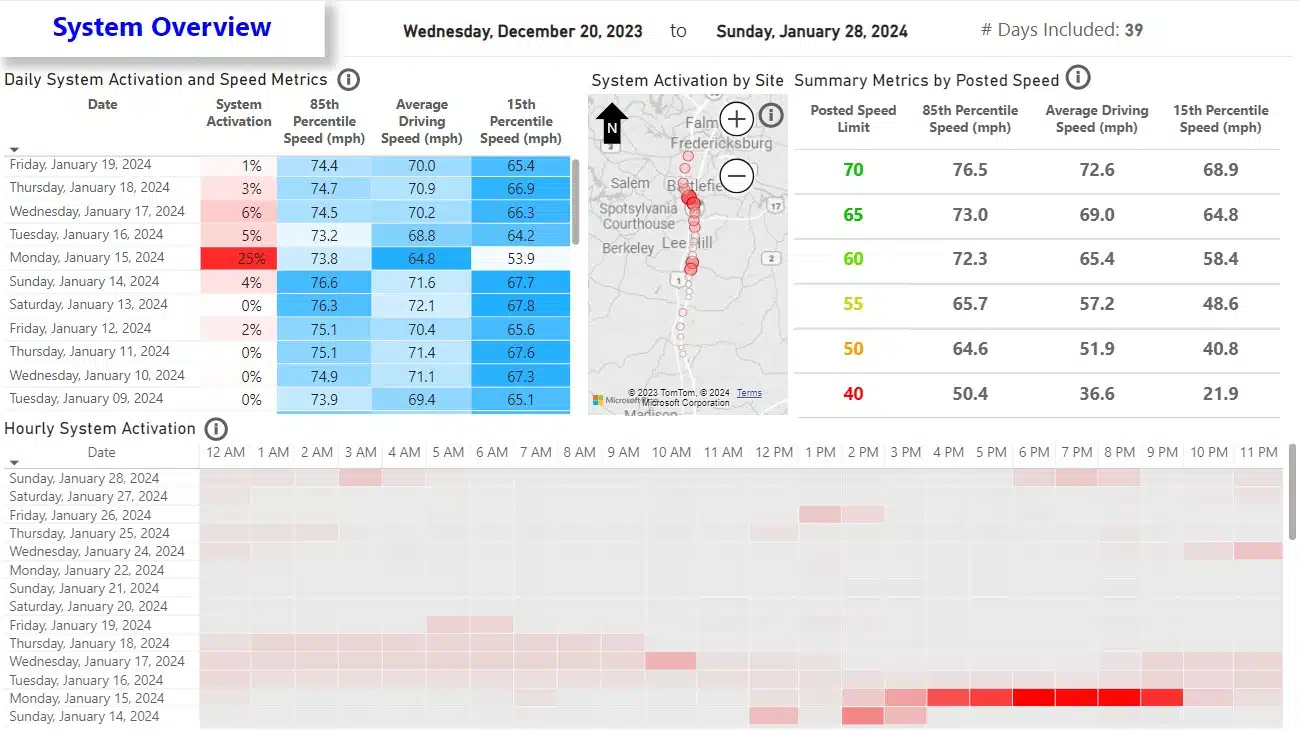Challenge
Dense traffic was clogging Virginia’s I-95 corridor, causing significant delays, unreliable travel times, and a high number of crashes, which only worsened on holidays and weekends.
Solution
After working with VDOT to evaluate I-95, we identified part of the corridor with severe congestion and a high crash rate and recommended the implementation of a predictive variable speed limit system that would incrementally reduce speed limits based on real-time traffic conditions.
Impact
Since the implementation of variable speed limits along the selected 15-mile stretch of I-95 northbound, there has been a 20% decrease in severe crashes, resulting in fewer fatalities and injuries.
The Challenge
Virginia’s Department of Transportation (VDOT) sought to improve traffic flow and safety along the highly traveled I-95 corridor, which connects millions of commuters to their destinations each day.
I-95 in Virginia is an essential corridor linking the communities of Richmond, VA, Fredericksburg, VA, and the Washington, DC metropolitan area. Playing a key role in travel along the eastern seaboard, I-95 experiences substantial daily congestion and frequent travel delays, which only worsen during vacation and holiday seasons. Additionally, crashes occur on this corridor as traffic moving at the speed limit intersects with vehicles that are stopped or slow-moving due to congestion, construction, or lane closures. To alleviate the impacts of heavy traffic demand on this corridor, VDOT began searching for solutions that would offer drivers real-time information on constantly changing I-95 conditions and support a faster, safer, and more reliable travel experience.
Our Solution
Kimley-Horn worked with VDOT to develop an improvement plan, which included the implementation of variable speed limits (VSL) and customization of a predictive control algorithm that leverages real-time traffic data.
An example of how variable speed limits react to hazards
Alongside VDOT, our team evaluated 179 miles of I-95 in Virginia to create a corridor improvement plan. We recommended the implementation of VSL along a 15-mile section of northbound I-95, between mile markers 115-130. The goal of VSL implementation in this area is to strategically manage speed limits based on evolving conditions and slow down traffic accordingly—thereby reducing the risk of crashes.
After receiving VDOT’s approval to move forward with integrating VSL along the identified part of I-95, our team developed a customized congestion prediction algorithm that leverages real-time and historical traffic data to incrementally adjust speed limits based on travel conditions. We also integrated KITS™, Kimley-Horn’s adaptable freeway and arterial transportation management system, with the VSL algorithm to enable VDOT to monitor system performance in real time.
Finally, our team developed a series of user-friendly PowerBI dashboards to report system metrics, such as the frequency of reduced posted speeds, driving speed by posted speed limit, and traffic volume by site.
The Impact
With the help of Kimley-Horn's team, VDOT has already reported an increase in driver safety and traffic flow along the 15-mile stretch of the corridor.
Since launching the system in June 2022, VDOT and the Kimley-Horn team have leveraged the dashboards we built to efficiently monitor system performance. This ability to track driver responses and system functionality has enabled the team to tune algorithm parameters and optimize performance, leading to a robust VSL system that has already changed travel in the region.
After the implementation of the VSL infrastructure, VDOT reported a decrease in the number of drivers traveling at high speeds and a more than 20% decrease in severe crashes. As VDOT considers integrating VSL along more of their corridors to streamline travel for Virginia residents and visitors, this initial I-95 speed management strategy serves as an adaptable and responsive model for future projects.
Project Recognition
- 2023 American Association of State Highway and Transportation Officials America’s Transportation Award
- 2023 National Operations Center of Excellence Traffic System Management and Operations (TSMO) Awards, Overall Winner and TSMO and Safety Winner
- 2023 WTS-DC Innovative Transportation Solutions Award
- 2023 American Council of Engineering Companies of Virginia, Engineering Excellence Awards, Honor Award
- 2023 Virginia Commissioner Award for Excellence
Get Started
Submit the form below to get more information about how KITS can help your agency seamlessly integrate and manage your ITS systems.

